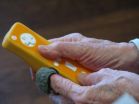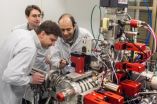(Press-News.org) Two novel radiolabeled small molecules targeting prostate-specific membrane antigen (PSMA) have excellent potential for further development as diagnostic and therapeutic radiopharmaceuticals, according to research published this month in The Journal of Nuclear Medicine. The imaging agents—123I-MIP-1072 and 123I-MIP-1095—were shown to have a high sensitivity of lesion detection in bone, soft tissue and the prostate gland with minimal retention in non-target tissue.
An estimated 238,500 men will be diagnosed with prostate cancer in 2013, and 29,700 will die from the disease. Accurate diagnosis and staging of prostate cancer is critical to determining appropriate patient management. Patients with localized disease may benefit from a curative treatment, while those with bone metastases are typically treated with systemic therapy.
"Current imaging techniques have limitations in diagnosing and staging prostate cancer. New imaging approaches, including the radiolabeled small molecules 123I-MIP-1072 and 123I-MIP-1095, may assess disease status more accurately," said John J. Babich, PhD, lead author of the article "First-in-Man Evaluation of Two High-Affinity PSMA-Avid Small Molecules for Imaging Prostate Cancer." Babich continued, "Improved imaging approaches could better facilitate the selection of optimal treatment and improve patient outcomes."
Separate studies were conducted as part of phase 1 trials under an investigational new drug application to measure the potential effectiveness of the small molecules in diagnosing and staging prostate cancer. In the first study, seven patients with documented prostate cancer were administered doses of 123I-MIP-1072 and 123I-MIP-1095 two weeks apart. In the second study, six healthy volunteers received 123I-MIP-1072 only. Whole body planar imaging and single photon emission computed tomography (SPECT)/computed tomography (CT) were performed for each group, and pharmacokinetics, tissue distribution, excretion, safety and organ radiation dose were analyzed.
Both 123I-MIP-1072 and 123I-MIP-1095 visualized lesions in soft tissue, bone and the prostate gland as early as one to four hours after injection. The imaging agents cleared the blood in a biphasic manner; however, clearance of 123I-MIP-1072 was approximately five times faster, resulting in a higher lesion-to-background ratio as compared to 123I-MIP-1095. The largest organ-absorbed radiation doses for 123I-MIP-1072 were to the urinary bladder, salivary glands, and kidneys; for 123I-MIP-1095 the absorbed doses to the salivary glands, kidneys and thyroid were the largest. Both imaging agents were well tolerated by the study population.
As a result of the phase 1 findings, 123I-MIP-1072 was evaluated as a diagnostic agent in subsequent clinical trials on the basis of its higher lesion-to-background ratios and prolonged tumor retention. 123I-MIP-1095 will be clinically evaluated for radiotherapy for metastatic prostate cancer as the 131I-labeled analog.
"A more accurate method of imaging prostate cancer and prostate cancer metastases would significantly impact the clinical management of men with prostate cancer. This would provide greater certainty as to the presence and extent of disease during the course of the patient's treatment," said Babich. "Data indicate that PSMA is an excellent target for molecular imaging of prostate cancer and that radiolabeled small molecules, which bind PSMA with high affinity, can localize prostate cancer anywhere in the body. The use of SPECT for molecular imaging could represent a significant advance in cancer evaluation."
###
Authors of the article "First-in-Man Evaluation of Two High-Affinity PSMA-Avid Small Molecules for Imaging Prostate Cancer" include John A. Barrett, Thomas Armor, Kevin P. Maresca, John L. Joyal, William C. Eckelman and John W. Babich, Molecular Insight Pharmaceuticals, Inc., Cambridge, Massachusetts; R. Edward Coleman and Neil A. Petry, Duke University, Durham, North Carolina; Stanley J. Goldsmith and Shankar Vallabhajosula, New York Weill Cornell Medical Center, New York, New York; Steve Cho, Johns Hopkins Medical Institution, Baltimore, Maryland; and James B. Stubbs and Michael G. Stabin, Radiation Dosimetry Systems, Inc., Alpharetta, Georgia. Molecular Insight, which was recently acquired by Progenics Pharmaceuticals, Inc., has a proprietary commercial interest in the compounds discussed in this release.
Novel small molecules used to visualize prostate cancer
2013-03-05
ELSE PRESS RELEASES FROM THIS DATE:
Are new national policies designed to reduce hospital readmissions working?
2013-03-05
New Rochelle, NY, March 5, 2013–Reducing preventable hospital readmissions is a cornerstone of emerging healthcare policy. The U.S. government has developed payment policies that will decrease payments to hospitals with excess patient readmission levels, for example. Early lessons learned from these current policy initiatives hint at their likelihood for success and are examined in an insightful article in Population Health Management, a peer-reviewed journal from Mary Ann Liebert, Inc., publishers. The article is available free on the Population Health Management website ...
EEG patterns indicate when patients lose, regain consciousness under propofol anesthesia
2013-03-05
Massachusetts General Hospital (MGH) investigators have identified specific EEG (electroencephalogram) signatures that indicate when patients lose and regain consciousness under the general anesthetic drug propofol. Their report being published online in PNAS Early Edition is part of a major MGH-based investigation into the mechanisms behind general anesthesia and builds on the results of a November 2012 paper.
"We have discovered highly structured EEG patterns that indicate when people are sedated during administration of propofol, when they are unconscious and when ...
Seniors who play video games report better sense of emotional well-being
2013-03-05
New research from North Carolina State University finds that older adults who play video games report higher levels of emotional well-being.
Researchers asked 140 people aged 63 and older how often they played video games, if at all. The study participants then took a battery of tests to assess their emotional and social well-being. 61 percent of study participants played video games at least occasionally, with 35 percent of participants saying they played at least once per week.
The study found that participants who played video games, including those who only played ...
Before and after: Ad placement should reflect cultural conceptions of time
2013-03-05
Consumers respond more favorably to advertising when the placement of product images is consistent with the way they visualize time, according to a new study in the Journal of Consumer Research.
"Whether a product's image is placed on the left or the right of an advertisement matters for products promising results occurring over time (weight loss aids or anti-aging creams) or products that are valued because they are old or new (antique furniture, modern art, wine, new technologies)," write authors Boyoun (Grace) Chae and JoAndrea Hoegg (both University of British Columbia).
Consumers ...
U of M researchers utilize genetically corrected stem cells to spark muscle regeneration
2013-03-05
MINNEAPOLIS/ST. PAUL (March 5, 2013) – Researchers at the University of Minnesota's Lillehei Heart Institute have combined genetic repair with cellular reprogramming to generate stem cells capable of muscle regeneration in a mouse model for Duchenne Muscular Dystrophy (DMD).
The research, which provides proof-of-principle for the feasibility of combining induced pluripotent stem cell technology and genetic correction to treat muscular dystrophy, could present a major step forward in autologous cell-based therapies for DMD and similar conditions and should pave the way ...
The Joint Facial and Invasive Neck Trauma (J-FAINT) Project, Iraq and Afghanistan 2003-2011
2013-03-05
Alexandria, VA — With over 37,000 face and neck injuries in more than 7,000 military personnel during Operations Iraqi Freedom (OIF) and Enduring Freedom (OEF), a new study in Otolaryngology–Head and Neck Surgery concludes additional training in the management of these injuries and improvements in body armor could be beneficial.
The authors note that OIF and OEF have changed the way military surgeons approach facial and penetrating neck trauma. "This study highlights the need for a trained head and neck surgeon in the deployed environment to address these changes and ...
Comparison investing: Why are consumers more willing to take risks when they can compare products?
2013-03-05
Consumers are more willing to take risks and accept delays in exchange for greater benefits when they are able to compare products, according to a new study in the Journal of Consumer Research.
"Rationally speaking, consumer preferences should be the same whether their product choices are presented side-by-side and evaluated comparatively or presented one at a time and evaluated in isolation, but it makes a remarkable difference in consumer decision-making," write authors Christopher K. Hsee (University of Chicago Booth School of Business), Jiao Zhang (University of Miami), ...
Targeting diet products: Why are more independent consumers better at delaying gratification?
2013-03-05
Product benefits that occur later in time are more likely to appeal to more independent consumers than to those who are more group or family oriented, according to a new study in the Journal of Consumer Research.
"More independent consumers think of the future in abstract terms and perceive future events as happening in the more distant future, whereas consumers who are less independent think of the future in concrete terms and perceive future events as happening sooner," write authors Gerri Spassova (Monash University) and Angela Y. Lee (Kellogg School of Management, ...
Texas A&M research contributes to improved ultrasound imaging
2013-03-05
Ultrasound technology could soon experience a significant upgrade that would enable it to produce high-quality, high-resolution images, thanks to the development of a new key material by a team of researchers that includes a professor in the Department of Biomedical Engineering at Texas A&M University.
The material, which converts ultrasound waves into optical signals that can be used to produce an image, is the result of a collaborative effort by Texas A&M Professor Vladislav Yakovlev and researchers from King's College London, The Queen's University of Belfast and ...
On the trail of mucus-eaters in the gut
2013-03-05
This press release is available in German.
The microbiology team of David Berry, Alexander Loy and Michael Wagner from the Faculty of Life Sciences, in collaboration with scientists at the Max F. Perutz Laboratories (University of Vienna and the Medical University of Vienna) and with the help of NanoSIMS technology, has for the first time succeeded in directly observing microorganisms feeding on the intestinal mucosa. The results of this research project appear in the current issue of the prestigious journal "Proceedings of the National Academy of Sciences" (PNAS).
To ...


